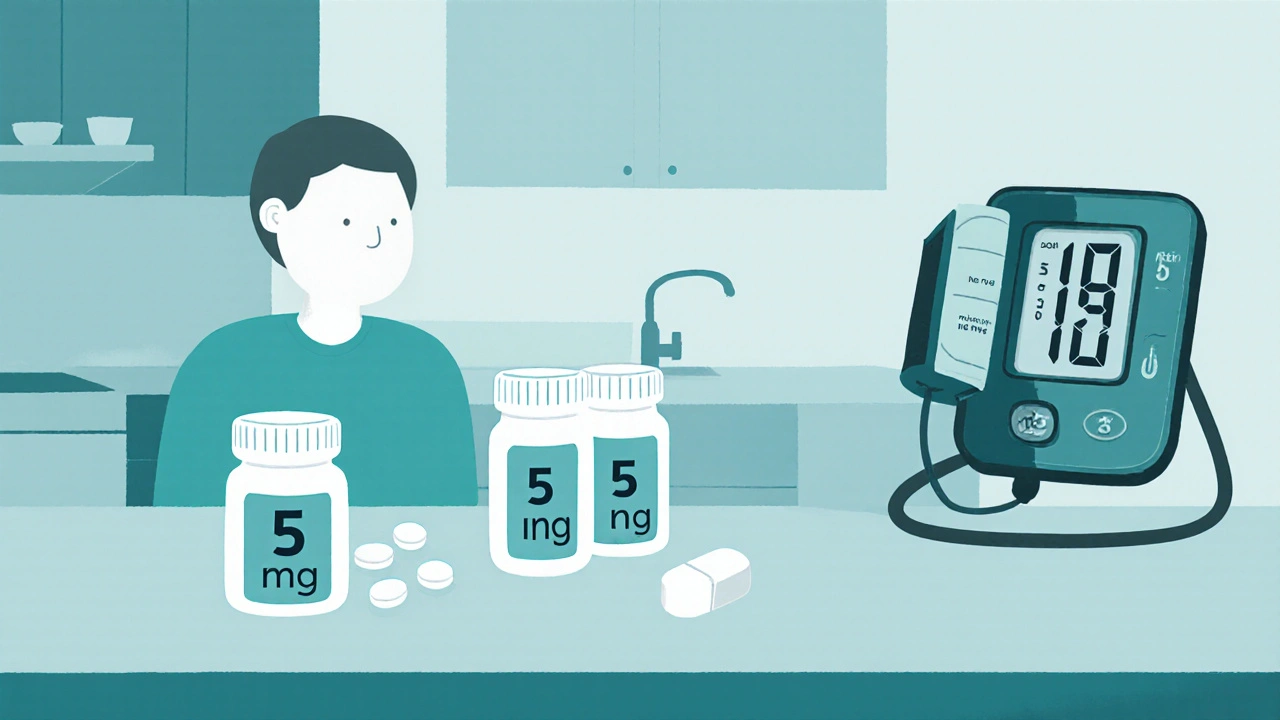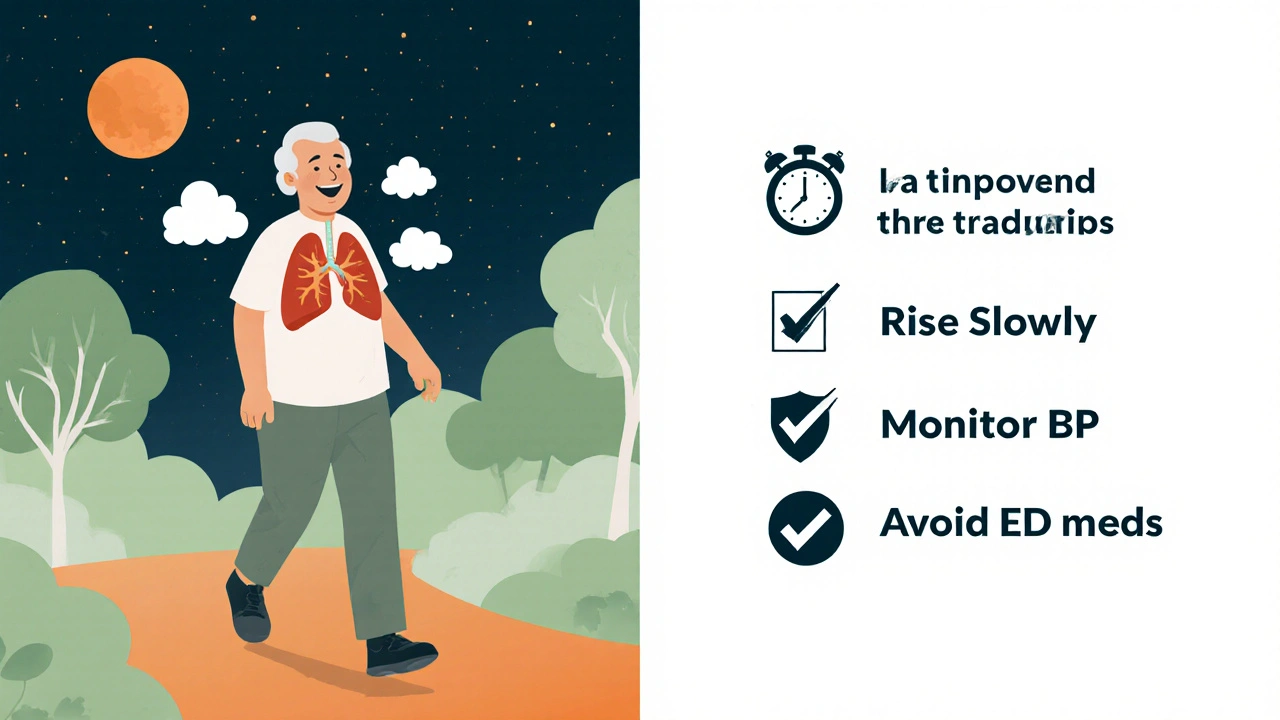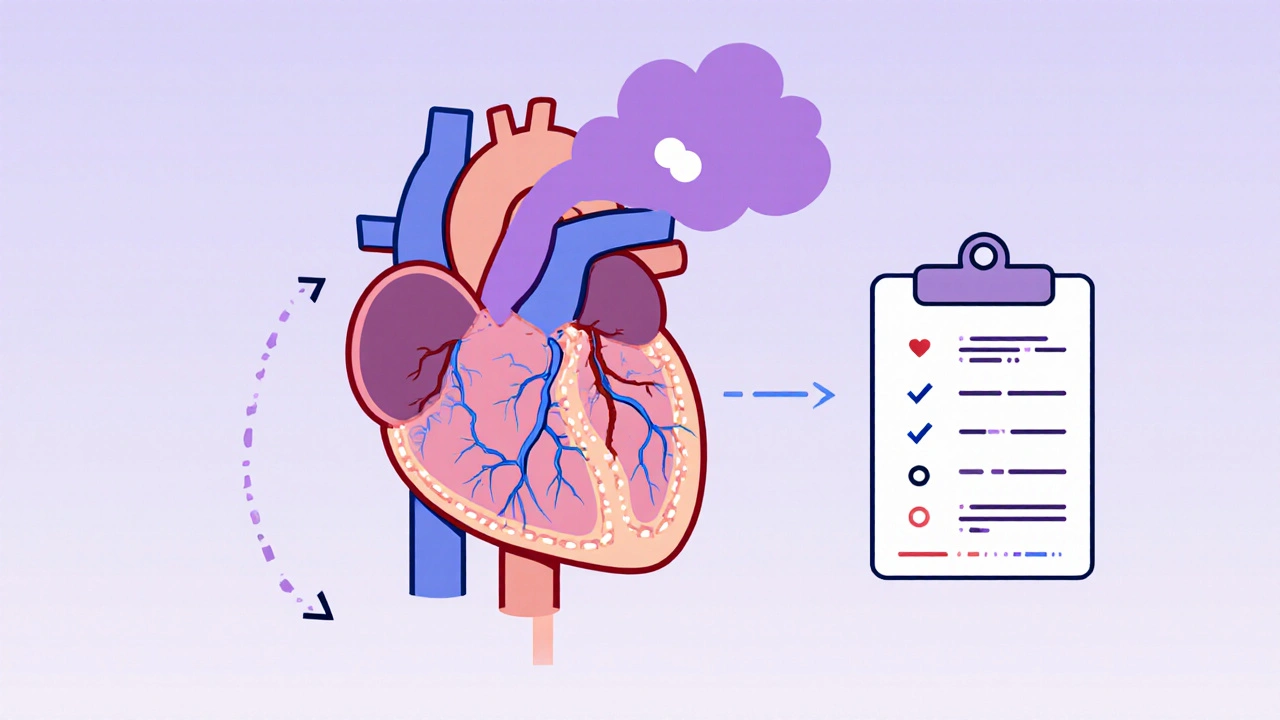Key Takeaways
- isosorbide dinitrate helps reduce heart workload by dilating veins, improving symptoms in chronic heart failure.
- It is most effective when paired with a long‑acting ACE inhibitor or ARB.
- Start low, titrate slowly, and watch for low blood pressure, headache, or rapid heart rate.
- Regular labs and blood pressure checks are essential to avoid tolerance and kidney issues.
- Know the differences between oral isosorbide dinitrate and nitroglycerin patches - duration and dosing matter.
What Is Isosorbide Dinitrate?
When you first see the name Isosorbide Dinitrate is a long‑acting organic nitrate prescribed to widen blood vessels and lower cardiac filling pressures. It was first approved in the 1950s and has become a staple for patients with angina and certain forms of heart failure.
Understanding Congestive Heart Failure
Congestive Heart Failure is a condition where the heart cannot pump blood efficiently, leading to fluid buildup in the lungs and peripheral tissues. The syndrome is classified by ejection fraction: reduced (<40 %), mildly reduced (40‑49 %), or preserved (>50 %). Managing fluid overload, reducing ventricular wall stress, and improving blood flow are core goals.
How Isosorbide Dinitrate Works in Heart Failure
The drug releases nitric oxide, which triggers smooth‑muscle relaxation in veins more than arteries. This venodilation lowers preload (the amount of blood returning to the heart) and, at higher doses, can also reduce afterload. By easing the heart’s filling pressure, patients often feel less shortness of breath and have better exercise tolerance.

When to Use Isosorbide Dinitrate in CHF
Guidelines from the American College of Cardiology/American Heart Association (ACC/AHA) suggest adding a nitrate‑hydralazine combo for patients who remain symptomatic despite optimal ACE‑inhibitor/ARB and beta‑blocker therapy, especially in African‑American populations. Isosorbide dinitrate alone can also be considered when hydralazine is not tolerated.
Dosage and Administration
- Start with 5 mg taken orally two to three times daily.
- Increase by 5 mg every 3‑5 days as tolerated, aiming for a total daily dose of 20‑40 mg split throughout the day.
- For patients with renal impairment (eGFR < 30 mL/min), stay at the low end of the dosing range.
- Take the medication with food to reduce gastric upset.
- Avoid taking the last dose after 7 p.m. to lower the risk of nocturnal hypotension.
Always time the dose to maintain a steady plasma level; a common regimen is “morning, midday, early evening.”
How It Stacks Up Against Nitroglycerin
| Attribute | Isosorbide Dinitrate | Nitroglycerin |
|---|---|---|
| Onset of action | 30‑60 minutes | 1‑3 minutes (IV) or 5‑10 minutes (oral) |
| Duration | 6‑12 hours (oral) | 30‑60 minutes (oral); 1‑4 hours (transdermal) |
| Typical dose | 5‑40 mg/day divided | 0.4‑0.8 mg sublingual PRN or 0.2‑0.4 mg/hr patch |
| Use in CHF | Yes, chronic management | Primarily for acute angina; not first‑line for CHF |
| Tolerance risk | Low with drug‑free interval each night | Higher; requires nitrate‑free period |
Combining Isosorbide Dinitrate with Other Heart‑Failure Medications
Standard therapy for CHF includes ACE inhibitors (or ARBs), beta‑blockers, and mineralocorticoid receptor antagonists. Adding a nitrate can provide extra preload reduction, but you must watch for additive hypotension.
- ACE inhibitors/ARBs - improve survival; nitrate may lower blood pressure further, so start low.
- Beta‑blockers - control heart rate; avoid excessive bradycardia when both drugs lower sympathetic tone.
- Diuretics - manage fluid; nitrates can potentiate diuretic‑induced drops in blood pressure.
- Hydralazine - often paired with isosorbide dinitrate in African‑American patients; the combo improves mortality.

Monitoring, Side Effects, and Contra‑indications
Regular follow‑up is critical. Check blood pressure, heart rate, and renal function at baseline, then after each dose increase.
- Common side effects: headache, dizziness, flushing, tachycardia.
- Serious risks: severe hypotension, reflex tachyarrhythmias, methemoglobinemia (rare, more with high IV doses).
- Contra‑indications: known hypersensitivity, severe anemia, recent phosphodiesterase‑5 inhibitor use (dangerous blood‑pressure drop).
- Drug interactions: concurrent use of sildenafil, tadalafil, or vardenafil; also caution with other vasodilators (hydralazine, nitroprusside).
If a patient experiences a headache, a short‑acting analgesic or a brief nitrate‑free interval can help. Persistent low blood pressure warrants dose reduction or temporary discontinuation.
Practical Tips & Common Pitfalls
- Schedule a nitrate‑free period each night (usually 8‑10 hours) to prevent tolerance.
- Educate patients to rise slowly from sitting to avoid orthostatic dizziness.
- Use a medication list card - many patients forget that over‑the‑counter erectile‑dysfunction pills interact badly.
- For seniors, start at the lowest dose and monitor renal function closely.
- Consider a home blood‑pressure log; trends help fine‑tune dosing without frequent clinic visits.
Frequently Asked Questions
Can I take isosorbide dinitrate if I’m already on a nitroglycerin patch?
Generally no. Both are nitrates and can cause severe low blood pressure. If a switch is needed, do it under physician supervision and allow a nitrate‑free window between products.
How quickly will I notice symptom improvement?
Most patients feel less shortness of breath and fewer ankle swellings within 1‑2 weeks of reaching a stable dose, but full benefit may take up to a month.
Is it safe during pregnancy?
Isosorbide dinitrate is classified as FDA Pregnancy Category C. It should only be used if the potential benefit justifies the risk. Discuss alternatives with your obstetrician.
What should I do if I miss a dose?
Take the missed dose as soon as you remember, unless it’s within 2 hours of the next scheduled dose. In that case, skip the missed one and resume your regular schedule.
Can older adults use this medication safely?
Yes, but they often need lower starting doses and closer monitoring for hypotension and kidney function. A pharmacist can help tailor the regimen.
Bottom Line
Isosorbide dinitrate remains a valuable tool in the heart‑failure arsenal when used correctly. Pair it with proven therapies, titrate slowly, watch blood pressure, and never skip the nightly nitrate‑free interval. With these steps, many patients experience better breathing, less swelling, and an overall improvement in quality of life.

Zaria Williams
Look, nobody needs a fancy lecture on nitrates when the basics are so simple; isosorbide dinitrate just venodilates and cuts preload, so you breathe easier. But folks keep overcomplicatin it with endless dosing charts – you could start low, like 5 mg, and just watch the BP drop. If you feel a headache, that’s just your body adjusting, not a sign to quit. Remember, the night‑time nitrate‑free window is a must, otherwise tolerance builds faster than a Netflix binge. Bottom line: stick to the schedule, and you’ll see improvement without the drama.
Buddy Bryan
First off, the titration schedule in the article is spot‑on, but you can tighten it a bit for patients who tolerate the drug well – increase by 5 mg every 48 hours instead of waiting 3‑5 days, provided their systolic stays above 90 mmHg. Pair it with an ACE‑inhibitor or ARB; the synergistic preload reduction cuts mortality by up to 15 % in African‑American cohorts. Do NOT forget to schedule a nitrate‑free interval of at least 8 hours each night; otherwise you’ll see rebound hypertension and tolerance. Monitor labs weekly for renal function when eGFR is under 30, and adjust the dose down by 10 mg if creatinine spikes. Finally, educate patients to avoid sildenafil or tadalafil – the combo can drop BP to dangerous levels in seconds.
Jonah O
They dont want you to know that the pharma giants push isosorbide dinitrate as a distraction from the real cure – the one they suppressed years ago. Think about it, the same pathways that control nitric oxide also regulate the mind, so why keep it hidden? The data in the ACC/AHA guidlines are cherry‑picked, and the nitrate‑hydralazine combo is just a smokescreen for larger profit margins. If you dig deeper you’ll see patterns of trial designs that exclude minorities unless they buy the combo. Wake up, the truth is out there, hidden behind the veil of "clinical trials".
Aaron Kuan
Pure venodilation, crisp relief, no drama.
Corrine Johnson
Isosorbide dinitrate, a venerable nitrate, has traversed the annals of cardiology, emerging from the 1950s as a stalwart against angina, only to find renewed purpose in the battle against congestive heart failure; its mechanism, rooted in nitric oxide donation, orchestrates a symphony of venous dilation, preload reduction, and, at higher doses, afterload modulation, thereby easing the cardiac burden, a principle that resonates with the ancient wisdom of balancing forces within the body, yet modern clinicians often overlook the subtleties of its pharmacokinetics, which demand a meticulous, time‑crafted dosing schedule, inclusive of a nightly nitrate‑free window, lest tolerance erode its efficacy; the dosage titration, beginning at 5 mg twice daily, escalating by 5 mg increments every three to five days, reflects a cautious optimism that mirrors the physician’s duty to safeguard against hypotension, orthostatic dizziness, and reflex tachycardia, each a potential pitfall in the therapeutic journey; moreover, the interplay with ACE inhibitors or ARBs, which themselves lower afterload, creates a harmonious duet, a pharmacologic chorus that, when finely tuned, can reduce mortality by a measurable margin, especially in African‑American populations where the nitrate‑hydralazine combination has been shown to confer additional survival benefits, a fact that underscores the importance of personalized medicine; however, the potential for drug‑drug interactions, particularly with phosphodiesterase‑5 inhibitors, cannot be dismissed, as the resultant precipitous blood pressure decline may culminate in catastrophic events, an outcome that should galvanize prescribers to scrutinize medication lists, educate patients, and employ vigilance in monitoring renal function, especially in those with eGFR below 30 ml/min, where dosage adjustments become imperative; the table contrasting isosorbide dinitrate with nitroglycerin elucidates differences in onset, duration, and tolerance risk, reinforcing the clinician’s choice of the former for chronic management versus the latter's role in acute angina scenes; in practical terms, a home blood‑pressure log, a medication card highlighting nitrate‑free periods, and a patient‑centered discussion about rising from seated positions slowly constitute the tangible steps that translate pharmacology into real‑world benefit; nevertheless, the shadow of tolerance looms, demanding that each night, a nitrate‑free interval of at least eight hours be respected, a simple yet profound maneuver that preserves the drug’s potency; finally, the broader implication of this therapy lies in its capacity to improve quality of life, reducing dyspnea, ankle edema, and hospitalization rates, thereby reaffirming the timeless adage that the simplest interventions, when applied judiciously, can yield the most profound outcomes.